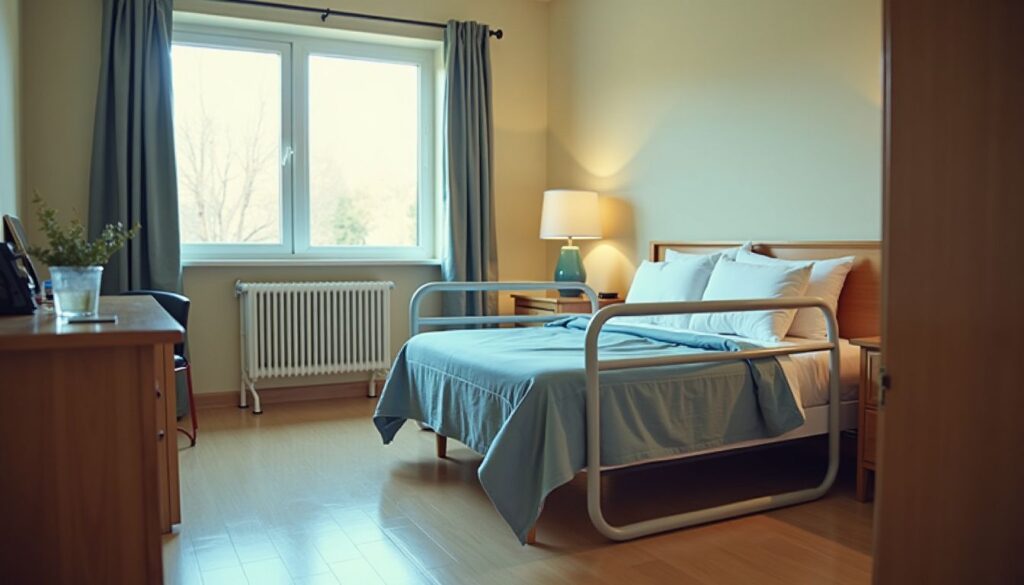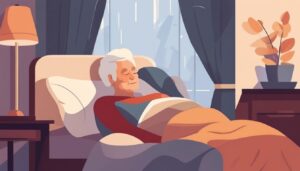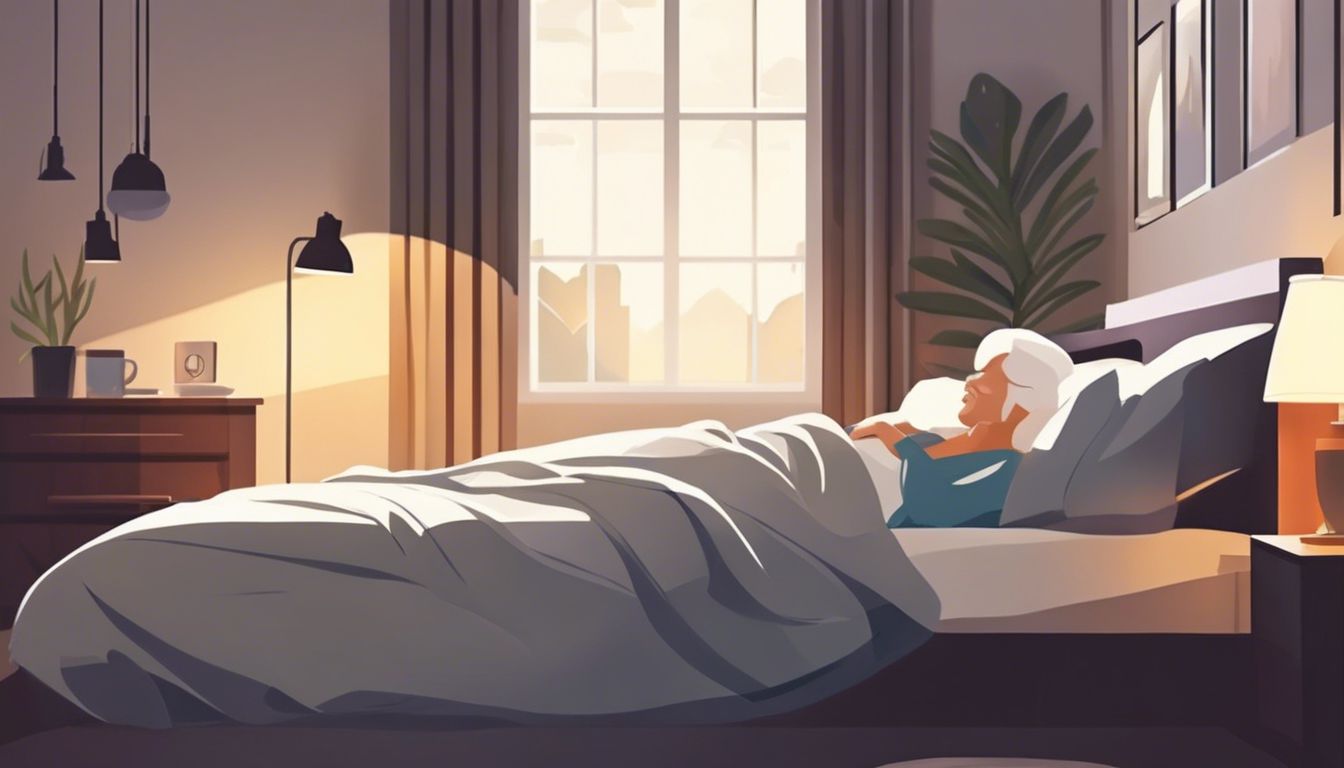Finding the perfect bedroom setup for caregivers is crucial. A ground floor room avoids stair troubles, which helps seniors. This article offers tips to create a safe, comfortable space for both caregiver and senior.
Discover how….
Key Takeaways
- Adjustable beds and bed railings help caregivers and seniors. They make getting in and out of bed easier.
- Floors that don’t slip prevent falls. Safety strips on hardwood or laminate are good choices.
- Smart lights and thermostats control the room easily, making it safe and comfy.
- Keep only needed furniture for more room to move around safely at night.
- Soft colors like light blues create a calm space that helps with sleep after caring all day.
Essential Features of a Caregiver’s Bedroom

A caregiver’s bedroom needs special things to make caring easier and safer. Think beds that move up and down, floors that stop slips, and lights at night. This setup helps both the caregiver and the one they care for stay comfortable and avoids accidents.
Adjustable Beds for Comfort and Accessibility
Adjustable beds are a must for caregivers. These beds move to help the person get in and out easily. They change height from 25 to 36 inches. Adding bed railings keeps the person safe.
Such beds make caring easier. Caregivers can adjust them for feeding or reading without strain. This helps both the caregiver and those they look after have less stress and more comfort.
Slip-Resistant Flooring to Prevent Accidents
Slip-resistant flooring keeps everyone safe. It stops falls before they happen. Floors like hardwood or laminate with safety strips are best. They help caregivers move without worry.
Managing cords is also key to prevent tripping. Keeping cords away from walkways and taping them down makes a big difference. This setup helps people aging in place feel safer at home.
It cuts down on accidents, making care easier for everyone involved.
Technology to Enhance Caregiving
Tech makes caregiving easier. Smart lights and thermostats help control a room with ease, keeping things safe and comfy without a lot of hassle.
Smart Technology for Lighting and Temperature Control
Smart technology changes the game in bedrooms for caregivers. It helps keep rooms bright and at the right temperature without hassle. Think of gadgets like touch-activated bedside lights and motion-sensor under-bed illumination.
These make it easy to guide late-night visits without turning on harsh overhead lights.
Temperature control is another area where smart technology shines. Programmable thermostats let you set ideal temperatures for both day and night, ensuring comfort without constant adjustment.
With smart lighting and temperature controls, caregiving becomes a bit easier, ensuring comfort with just a few taps.
Design Considerations for Efficiency and Safety
Making a bedroom safe and easy to use helps caregivers do their job better. Think about clear paths, good lighting, and calm colors. Read on for more tips!
Minimized Furniture for Easy Mobility
Keep only must-have furniture in the bedroom. This means a bed, bedside table, reading chair, and chest of drawers. Less furniture makes it easier to move around. It helps both caregivers and those they care for.
Get rid of any unstable pieces or things you might trip over. This setup is not just about saving space. It also lowers the risk of accidents.
Having more room allows for quick access to assistive devices like safety rails and even stair lifts if needed. Ample space can make using these tools smoother and safer day or night.
Caretakers find this layout helpful in emergency situations too—it’s easier to reach someone fast without obstacles in the way.
Ample Lighting to Ensure Safety at Night
Bright lights matter a lot for safety at night. Add touch-activated bedside lamps to make it easy. They turn on with a simple tap. Motion-sensor under-the-bed lighting also helps, lighting up as soon as someone steps out of bed.
This way, paths are always clear and accidents drop.
Good lighting is not just about seeing better; it’s about moving safely in the dark.
Lamps and sensor lights help caregivers and those they look after move around safely when it’s dark. There’s no need to search for switches or stumble in the dark anymore. With these changes, nights become safer for everyone in the room.
Best Colors for a Caregiver’s Bedroom
Soft, muted colors work best in a caregiver’s bedroom. These shades help reduce stress and improve sleep quality. Think light blues, gentle greens, and warm neutrals. They create a calm space that promotes relaxation after long days of care.
Next, they also need the right furniture for easy movement and safety at night.
Conclusion on Creating Effective Caregiving Spaces
The best bedroom setups for caregivers put safety and comfort first. Simple changes make a big difference — like using beds that adjust, putting in floors that prevent slips, and having lights you can control easily.
Smart tech keeps the room just right with good lighting and temperature. Less furniture means moving around is easier. Bright colors lift spirits. Every detail, from the type of bed to the color on the walls, works together to help caregivers provide better care while staying comfortable themselves.
These setups support everyone’s well-being day and night.
For more insightful tips, check out our guide on the best colors for a caregiver’s bedroom.
FAQs
1. What factors should be considered in the best bedroom setup for caregivers?
In setting up a caregiver’s bedroom, consider factors like natural light, interior design that promotes easy movement and accessibility, and casegoods or furnishings that are both functional and comfortable.
2. How can I finance the expenses of a caregiver-friendly bedroom setup?
To cover the costs of creating an ideal caregiver’s room, you could look into getting a personal loan or using credit. Remember to check if any of your expenses are tax-deductible.
3. Is it better to move my elder care to nursing homes instead of modifying our home?
It depends on individual circumstances. While nursing homes provide professional care around the clock, having elder care at home provides a familiar environment which can be comforting.
4. Do I need to install an elevator when setting up my home for caregiving purposes?
While not always necessary, installing an elevator may greatly improve mobility within multi-story homes especially if nursing elderly individuals who have difficulty with stairs.









